Can GenZ and Boomers Find Peace?
The Pulse and Politics of the Environment, Peace, and Justice
Bob Musil, President, Rachel Carson Council
“In nature nothing exists alone.”
“The aim of science is to discover and illuminate truth. And that, I take it, is the aim of literature, whether biography or history… It seems to me, then, that there can be no separate literature of science.”
“If the Bill of Rights contains no guarantee that a citizen shall be secure against lethal poisons distributed either by private individuals or by public officials, it is surely only because our forefathers, despite their considerable wisdom and foresight, could conceive of no such problem.”
— Rachel Carson

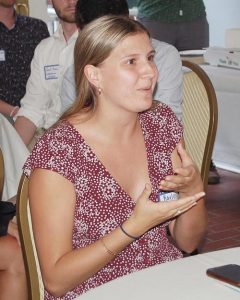 Thirty-five Rachel Carson Council (RCC) Fellows and staff, all young environmental leaders in their twenties, all Generation Z or Zoomers, listened intently, then fired questions at U.S. Representative Jamie Raskin, constitutional scholar, brilliant leader of the second impeachment of Donald Trump, and stalwart of the Congressional hearings on the January 6 insurrection. “Why isn’t there serious climate legislation?” was just for openers.
Thirty-five Rachel Carson Council (RCC) Fellows and staff, all young environmental leaders in their twenties, all Generation Z or Zoomers, listened intently, then fired questions at U.S. Representative Jamie Raskin, constitutional scholar, brilliant leader of the second impeachment of Donald Trump, and stalwart of the Congressional hearings on the January 6 insurrection. “Why isn’t there serious climate legislation?” was just for openers.
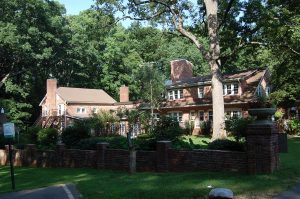 This diverse, talented group included the linchpins of fossil fuel divestment campaigns, the heads of a nationwide movement against herbicides on campus, advocates against the climate injustice of clear-cutting forests to produce wood pellets, and more.
This diverse, talented group included the linchpins of fossil fuel divestment campaigns, the heads of a nationwide movement against herbicides on campus, advocates against the climate injustice of clear-cutting forests to produce wood pellets, and more.
They are not shy. Selected from campuses around the nation, these RCC Fellows were gathered for the five-day RCC American Environmental Leadership Institute (AELI) at the wooded Rockwood Manor Retreat Center along the C&O Canal National Historic Park.
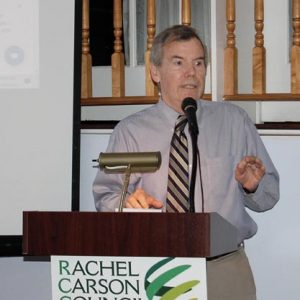 As I listened, I began to fear that perhaps the latest generation of environmental leaders was not quite as in awe of the nearly 60-year-old Raskin as I am. And then there is me — their senior environmental leader — older than most of their grandparents — like Al Gore, John Kerry, Joe Biden.
As I listened, I began to fear that perhaps the latest generation of environmental leaders was not quite as in awe of the nearly 60-year-old Raskin as I am. And then there is me — their senior environmental leader — older than most of their grandparents — like Al Gore, John Kerry, Joe Biden.
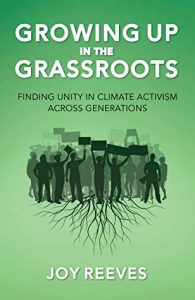 I need not have feared. Unlike the media stereotypes that drench us daily, these Zoomers were not dismissive of baby boomers, including their parents, whom many credited for their own social conscience and love for the environment. They were, indeed, in awe of Jamie Raskin. It is out of respect that they peppered him with tough questions. And then, one of RCC’s Duke Stanback Fellows, Joy Reeves, gave Raskin a signed copy of her book, Growing Up in the Grassroots: Finding Unity in Climate Activism Across Generations (New Degree Press, 2020). She had me read the opening.
I need not have feared. Unlike the media stereotypes that drench us daily, these Zoomers were not dismissive of baby boomers, including their parents, whom many credited for their own social conscience and love for the environment. They were, indeed, in awe of Jamie Raskin. It is out of respect that they peppered him with tough questions. And then, one of RCC’s Duke Stanback Fellows, Joy Reeves, gave Raskin a signed copy of her book, Growing Up in the Grassroots: Finding Unity in Climate Activism Across Generations (New Degree Press, 2020). She had me read the opening.
“Okay boomer.” Two simple words and the movement was launched. One dismissive little hashtag, and the Internet hosted the intergenerational feud defining the 2010’s…pitting postmodern “snowflakes” against backward “boomers.” Because the U.S. isn’t polarized enough, right?”
Reeve’s book should be required reading for both Gen Z and every aging American who thinks that young people just don’t know enough, care enough, or appreciate anyone but their own social media-driven generation.
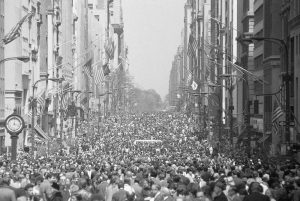 Here is her take on pitting the young against their elders: “I understand the frustration Gen Zers and millennials are expressing toward the outdated views of a few individual boomers (particularly with regard to social and racial justice) … [But] In my field, environmental science and policy, the vast majority of climate data, federal environmental agencies, and lifesaving pollution regulation systems were spearheaded by older generations. In fact, it was my parents’ generation who originally took to the streets on the first Earth Day in 1970 and throughout the decade…”
Here is her take on pitting the young against their elders: “I understand the frustration Gen Zers and millennials are expressing toward the outdated views of a few individual boomers (particularly with regard to social and racial justice) … [But] In my field, environmental science and policy, the vast majority of climate data, federal environmental agencies, and lifesaving pollution regulation systems were spearheaded by older generations. In fact, it was my parents’ generation who originally took to the streets on the first Earth Day in 1970 and throughout the decade…”
 And, wow, did these twenty-somethings love it when the leading environmental advocate, Bill McKibben, a classmate and friend of Raskin’s, joined us by Zoom. He and Raskin traded jokes, greetings, and elder wisdom before McKibben gave an upbeat talk that praised the RCC Fellows for their commitment and leadership, reminded them how students led the way in the divestment movement, and offered real hope that they could make a difference in the dark days ahead.
And, wow, did these twenty-somethings love it when the leading environmental advocate, Bill McKibben, a classmate and friend of Raskin’s, joined us by Zoom. He and Raskin traded jokes, greetings, and elder wisdom before McKibben gave an upbeat talk that praised the RCC Fellows for their commitment and leadership, reminded them how students led the way in the divestment movement, and offered real hope that they could make a difference in the dark days ahead.
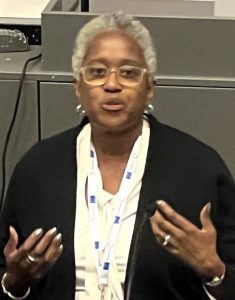 But sometimes, GenZ activists can’t seem to win the stereotype struggle. When politically engaged, instead of self-absorbed and spoiled, they are painted as too impatient, too militant, lacking substance or sophistication. But I got to see these RCC Fellows, deeply engaged in conversation with an actual university administrator Renée White. White, Executive Vice President and Provost of the New School, a major private university in New York City with some 10,000 students, is like Bill McKibben, part of the RCC National Advisory Council, and about the same age.
But sometimes, GenZ activists can’t seem to win the stereotype struggle. When politically engaged, instead of self-absorbed and spoiled, they are painted as too impatient, too militant, lacking substance or sophistication. But I got to see these RCC Fellows, deeply engaged in conversation with an actual university administrator Renée White. White, Executive Vice President and Provost of the New School, a major private university in New York City with some 10,000 students, is like Bill McKibben, part of the RCC National Advisory Council, and about the same age.
She shared her own journey from student activist to the heights of academia as an environmental justice advocate. Then, I witnessed a dazzling dialogue between leaders two generations apart, now allies developing strategies to influence administrators and Boards of Trustees nationwide: “How do we get transparency with financial information?” “How useful is it to have our own reinvestment plan to offer to the Trustees?” Again, there was respect, even enthusiasm, that a university official cared deeply, offered candid advice, and respected them as environmental leaders.
 With good reason. Among the RCC Fellows at the AELI were the heads of divestment movements at Vanderbilt, Pomona, Tulane, and Catawba. I was humbled by the information and experience they shared in small group sessions with the RCC’s new Assistant Director of Communications and Strategic Development, Claudia Steiner. Steiner, before recruited to the Rachel Carson Council, led the final, successful campaign to divest all fossil fuels at American University. It was the culmination of work I had helped students initiate some dozen years ago. But, unlike the old days of 2010, Steiner had marshalled powerful social media and communications to bring divestment across the finish line. I simply watched and learned as she held her GenZ compatriots entranced and engaged in the most effective ways to use media to achieve success.
With good reason. Among the RCC Fellows at the AELI were the heads of divestment movements at Vanderbilt, Pomona, Tulane, and Catawba. I was humbled by the information and experience they shared in small group sessions with the RCC’s new Assistant Director of Communications and Strategic Development, Claudia Steiner. Steiner, before recruited to the Rachel Carson Council, led the final, successful campaign to divest all fossil fuels at American University. It was the culmination of work I had helped students initiate some dozen years ago. But, unlike the old days of 2010, Steiner had marshalled powerful social media and communications to bring divestment across the finish line. I simply watched and learned as she held her GenZ compatriots entranced and engaged in the most effective ways to use media to achieve success.
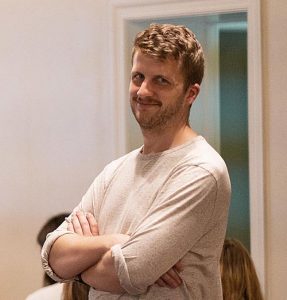 Throughout the AELI, our RCC Fellows also looked up to Mackay Pierce, the venerable Associate Director of the RCC who, at the old age of 27, heads our campus and Fellowship programs. Aside from handling logistics and running the entire AELI program, Pierce also had RCC Fellows probe the pragmatic details of how to plan and carry out an effective campus or community campaign. Pierce is on top of RCC campaigns nationwide, but also led the effort at his alma mater, Roanoke College, to plan, fund, design and build a community garden after saving land that was going to be paved. He also has built affordable housing, fought mountain top coal removal, and worked for environmental justice in his native Appalachia.
Throughout the AELI, our RCC Fellows also looked up to Mackay Pierce, the venerable Associate Director of the RCC who, at the old age of 27, heads our campus and Fellowship programs. Aside from handling logistics and running the entire AELI program, Pierce also had RCC Fellows probe the pragmatic details of how to plan and carry out an effective campus or community campaign. Pierce is on top of RCC campaigns nationwide, but also led the effort at his alma mater, Roanoke College, to plan, fund, design and build a community garden after saving land that was going to be paved. He also has built affordable housing, fought mountain top coal removal, and worked for environmental justice in his native Appalachia.
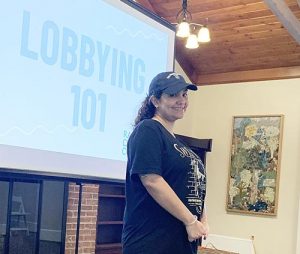 But many older environmentalists still worry that GenZ does not care enough about policy and politics to create long-range social and institutional change. I wished they could have seen RCC Assistant Director, Bella Jaramillo, rousing the assembled RCC Fellows to hilarious laughter, focused outrage, and serious, profound concern to get pragmatic results. Jaramillo, also in her early twenties, is a powerhouse Latina and a proud first-generation college graduate. As an undergraduate at Florida State in Tallahassee, the capital, Jaramillo continuously lobbied the Florida legislature and pulled together the first city-wide March for Science because no one else stepped up.
But many older environmentalists still worry that GenZ does not care enough about policy and politics to create long-range social and institutional change. I wished they could have seen RCC Assistant Director, Bella Jaramillo, rousing the assembled RCC Fellows to hilarious laughter, focused outrage, and serious, profound concern to get pragmatic results. Jaramillo, also in her early twenties, is a powerhouse Latina and a proud first-generation college graduate. As an undergraduate at Florida State in Tallahassee, the capital, Jaramillo continuously lobbied the Florida legislature and pulled together the first city-wide March for Science because no one else stepped up.
 As Jaramillo pepped up our Fellows with the joys of advocacy, I saw future office holders, heads of NGOs, and advocates for serious social change and climate justice from academia, journalism, and the arts emerging before me. As if living proof, Emily McAuliffe, Special Assistant to the Deputy Administrator of NOAA, joined us to share how she had gone from our very first Rachel Carson Council Fellow, to staff at House and Senate Committees, to a critical position at the federal agency responsible for the nation’s knowledge and data about global climate change. McAuliffe is twenty-six.
As Jaramillo pepped up our Fellows with the joys of advocacy, I saw future office holders, heads of NGOs, and advocates for serious social change and climate justice from academia, journalism, and the arts emerging before me. As if living proof, Emily McAuliffe, Special Assistant to the Deputy Administrator of NOAA, joined us to share how she had gone from our very first Rachel Carson Council Fellow, to staff at House and Senate Committees, to a critical position at the federal agency responsible for the nation’s knowledge and data about global climate change. McAuliffe is twenty-six.
Yet, I wondered, despite their obvious commitment to climate justice and social change, whether McAuliffe and our RCC Fellows and staff would continue their passion for environmental leadership far into the future. What would allow them to still be leaders, senior environmental leaders, in the 2060s or 70s – a century after Silent Spring and Earth Day, a hundred years after the college years of Raskin, McKibben, White, and my generation?
Rachel Carson saw her candidates lose, rivers burn, toxic chemicals spread, was reviled, ridiculed, and riven with breast cancer. But Carson did not fear the collapse of civilization from extreme climate change. Nor did she have evidence that the American political system might not be capable of the shifts necessary to stave off catastrophe. Or that democracy itself might be in danger. Who could blame this generation if they yielded to cynicism, despondency, despair? Or, given the times, if they simply turned to hedonism and selfishness, savoring the sweets of corporate capitalism before the planet burns.
Rachel Carson said:
“Those who contemplate the beauty of the earth find reserves of strength that will endure as long as life lasts. There is something infinitely healing in the repeated refrains of nature — the assurance that dawn comes after night, and spring after winter.”
Carson urged adults to develop a sense of wonder, like that of a child. She sought solace in the beauty of woods, rocky shores, and tidal pools in Maine and, after breast surgery, along the sandy beaches and small islands of North Carolina’s Outer Banks.
 And so, I was no longer surprised when the RCC Fellows responded profoundly to one more senior environmental leader I had invited to lead them in a “Walk in Wonder” into the woods along the C&O Canal. Melanie Choukas-Bradley is a popular nature author of numerous books like A Year in Rock Creek Park. She leads nature walks, tree and wildflower identification, kayak outings, and urban “forest bathing.” With the energy and enthusiasm of a GenZer, Choukas-Bradley’s personality is equal parts conservation expert, cheerleader, and compassionate counselor, or spiritual guru. She talked about how she was unemployed when first in Washington, how and why she wrote her books despite obstacles, and why she came to write her book Finding Solace at Theodore Roosevelt Island amidst the Trump years, climate crisis, and COVID pandemic. She drew upon nature for healing and strength; our Fellows could do the same.
And so, I was no longer surprised when the RCC Fellows responded profoundly to one more senior environmental leader I had invited to lead them in a “Walk in Wonder” into the woods along the C&O Canal. Melanie Choukas-Bradley is a popular nature author of numerous books like A Year in Rock Creek Park. She leads nature walks, tree and wildflower identification, kayak outings, and urban “forest bathing.” With the energy and enthusiasm of a GenZer, Choukas-Bradley’s personality is equal parts conservation expert, cheerleader, and compassionate counselor, or spiritual guru. She talked about how she was unemployed when first in Washington, how and why she wrote her books despite obstacles, and why she came to write her book Finding Solace at Theodore Roosevelt Island amidst the Trump years, climate crisis, and COVID pandemic. She drew upon nature for healing and strength; our Fellows could do the same.
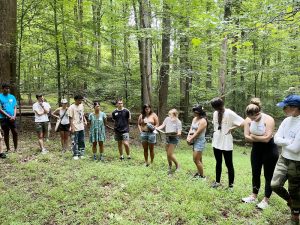 We headed outdoors, sniffed leaves and flowers, touched lichen and moss, identified white oaks and tulip trees, learned terms like petiole and lanceolate that seemed like sacred script. After exploring Rockwood Manor, we entered the C&O Canal woods in silence, urged to see with a child’s eye, to use all our senses, to breathe, feel, and absorb the nature around us. A bald-headed hornet sipping sap. Deep rectangular holes drilled by a crow-sized Pileated Woodpecker. The flutey song of the Wood Thrush. We entered a small clearing, formed a silent circle, and in hushed tones, read poetry aloud: Mary Oliver, Wendell Berry, the words of John Muir and Rachel Carson. Then, we each slowly wended our way back. I heard Wood Thrush and Baltimore Oriole, smelled loamy dirt and leaf litter, paused at a single, slim mushroom in a stream of light.
We headed outdoors, sniffed leaves and flowers, touched lichen and moss, identified white oaks and tulip trees, learned terms like petiole and lanceolate that seemed like sacred script. After exploring Rockwood Manor, we entered the C&O Canal woods in silence, urged to see with a child’s eye, to use all our senses, to breathe, feel, and absorb the nature around us. A bald-headed hornet sipping sap. Deep rectangular holes drilled by a crow-sized Pileated Woodpecker. The flutey song of the Wood Thrush. We entered a small clearing, formed a silent circle, and in hushed tones, read poetry aloud: Mary Oliver, Wendell Berry, the words of John Muir and Rachel Carson. Then, we each slowly wended our way back. I heard Wood Thrush and Baltimore Oriole, smelled loamy dirt and leaf litter, paused at a single, slim mushroom in a stream of light.
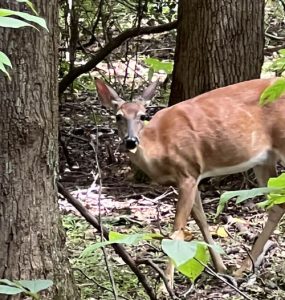 Suddenly, an RCC Fellow just ahead of me froze, her hand raised. A doe stood nibbling at the forest floor. She looked at us and moved slowly forward, unconcerned, as if in friendship. Still closer she came, until, only steps away, I was gazing into her deep brown eyes.
Suddenly, an RCC Fellow just ahead of me froze, her hand raised. A doe stood nibbling at the forest floor. She looked at us and moved slowly forward, unconcerned, as if in friendship. Still closer she came, until, only steps away, I was gazing into her deep brown eyes.
The divisions, the stereotypes, the clichés, the differences between humans and wildlife, plants and animals, urban and rural, young and old, had vanished. I felt childhood delight, wonder, awe, strength, some strange sense of inner peace.